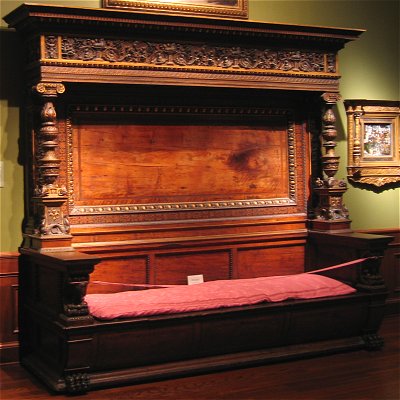Clarice's father was dead (1503). Clarice and Filippo were married in Rome in a simple wedding without solemn nuptials and Medici pageantry. The cassapanca, from which the trono originated, was a simple seat next to a bed, in the mid 14th century, in a plain unornamental form. It also was a storage area. In the 15th century, it took the form of a daybed in the master bedroom. As time progressed this became a more and more elaborately carved daybed -alettucio. Because of the elaborateness of the trono, it is presumed that this was more symbolic than functional. Then again, it was perhaps a seat of honor in the Strozzi family. The trono, inspired by Renaissance and classical architecture, has a high parallel back, flanked by pilasters beneath a heavy carved cornice which is supported by two gilded columns. The trono has both the Medici and Strozzi coat of arms: the seven palle (balls) and the three lune (crescents), respectively. The elaborately carved frieze contains the falcon with wings spread; the winged half monster alternating with the base of the lamb. The falcon was Clarice's uncle Pope Leo X 's impressa, as well as that of the elder Strozzi. The latter developed it while in exile (1458 - 1491), accompanied by the motto "Sic Virtue Expecto", a symbol of rebirth and triumph. The Strozzi lamb was the impressa representing meekness and humility. While Piero de Medici was in exile his impressa was the broken branch and three roses, also representing hope of returning to Florence. Unfortunately he never did, since he drowned in the Arno river in 1503. All these coat of arms and impresse are included in various parts of the trono. The intarsia, a frieze of geometric design, is another pre-eminent feature of the trono. It consists of inlaid wood painted or gilded. The rams, griffins, sphinxes and egg-and-dart motif are derived from the ancient Greece, again a revival interest of the Renaissance. Thus the trono is a piece of furniture in which rare artistic beauty and design execution are joined with great historic interest. Baccio d'Angolo (Bartolomeo d'Angolo di Donato Baglione) was born in Florence in 1462 and died in 1543. He was the son of a hosier turned woodcarver. He became the foremost woodcarver and architect in Florence. He was famous for intarsia inlay, picture frames and wooden ornaments in churches and palaces, such as the Palazzo Vecchio, and others. As an architect he designed some of the influential family palaces including the Strozzi palace and its piazza. Baccio's architecture never moved into the direction of Michelangelo's Maniera, which became so dominant in Florence. He worked almost all his life in Florence; however did go to Rome to study for a short time. |
